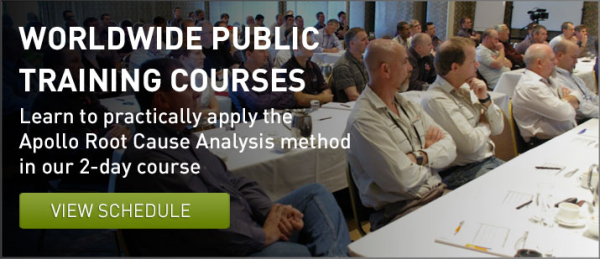Author: Gary Tyne CMRP
Following the release of a report by economic consultants Frontier Economics(Oct 2014), it was highlighted that the cost of errors in patient safety, which includes the cost of extra treatment, bed space and nursing care as well as huge compensation pay-outs, costs the NHS between £1billion and £2.5billion a year.
In a speech to staff at Birmingham Children's Hospital (Oct 2014), Jeremy Hunt (Health Secretary) said:
 “World class care is not just better for patients it reduces costs for the NHS as well. More resources should be invested in improving patient care rather than wasted on picking up the pieces when things go wrong.”
“World class care is not just better for patients it reduces costs for the NHS as well. More resources should be invested in improving patient care rather than wasted on picking up the pieces when things go wrong.”
As far back as 2010 Dame Christine Beasley, chief nursing officer for England said “using Root Cause Analysis (RCA) tools to understand adverse events is “critical” to improving safety across the NHS.”
The National Patient Safety Agency (NPSA) developed a set of root cause analysis guidelines and instruction documents which were taken over by the NHS Commissioning Board Special Health Authority in 2012.
Although the NPSA did not identify a specific RCA process to be used the toolkit advocates the use of the Fish-bone or Ishikawa diagram as a key tool for identifying contributory factors and root causes. Another method utilized within the NHS is a method called ‘5 Whys’
Whilst both Fishbone and 5 Whys are tools that can be utilized in basic problem solving, both methods have received criticism from within other industries for being too basic and not complex enough to analyze root causes to the depth that is needed to ensure that solutions are identified and the problem is fixed.
There are several reasons for this criticism:
- Tendency for investigators to stop at symptoms rather than going on to lower-level root causes
- Inability to go beyond the investigator’s current knowledge – cannot find causes that they do not already know
- Lack of support to help the investigator ask the right “why” questions
- Results are not repeatable – different people using Fishbone and 5 Whys come up with different causes for the same problem
- Tendency to isolate a single root cause, whereas each question could elicit many different root causes
- Considered a linear method of communication for what is often a non-linear event
Many companies we work with successfully utilize the 5 Why technique or Fishbone for very basic incidents or failures. By utilizing the correct placement of triggers, organizations can use the 5 Why or Fishbone for its basic problem solving and then move to a form of Cause and Effect analysis like the Apollo Root Cause Analysis methodology for more complex problems.
A disciplined problem solving approach should push teams to think outside the box, identifying root causes and solutions that will prevent reoccurrence of the problem, instead of just treating the symptoms.
Apollo Root Cause Analysis methodology – A New Way of Thinking

The Apollo Root Cause Analysis methodology provides a simple structured approach that can be applied by anyone, at any time on any given event. One of its most powerful attributes is its ability to create a common understanding of contributing causes, and provide a platform to explore a range of creative solutions. Through a simple charting process, everyone involved in an investigation can contribute which generates enthusiasm for the process, resulting in positive problem solving outcomes and experiences.
The key factor for successful problem solving is the inclusion of cause and effect as part of the analytical process.
Root Cause analysis identifies causes, so that solutions are based on controlling those causes, rather than treating the symptoms.
There are many features of the Apollo Root Cause Analysis methodology which naturally fit within any Problem Solving Excellence program.
The Apollo Root Cause Analysis methodology was developed in 1987 by Dean Gano and is utilized across the world in various industries from petrochemical, aerospace, utilities, manufacturing, healthcare and others.
The Apollo Root Cause Analysis process is a 4-step method for facilitating a thorough incident investigation. The steps are:
- Define the Problem
- Analyze Cause and Effect Relationships
- Identify Solutions
- Implement the Best Solutions
The Apollo Root Cause Analysis methodology is supported by software called RealityCharting™ which is available in full version (standalone or enterprise) or as RealityCharting™ Simplified. The RealityCharting Simplified can be utilized on smaller issues and allows the user to build a cause and effect chart that is no greater than 4 causes high and 5 causes deep. This allows the user of a 5 Whys approach the ability to create a chart using the same thought process adopted in the Apollo Root Cause Analysis™ methodology. It also demonstrates a non-linear output to what was originally considered a linear type problem.
Training in the NHS
In the study titled: ‘Training health care professionals in Root Cause Analysis: a cross-sectional study of post-training experiences, benefits and attitudes’ by Bowie, Skinner, de Wet. A few interesting statistics begin to arise when it comes to training of RCA with the respondents.
When asked ‘What type of training did you receive?’ 81.1% of respondents had said they had received in-house training compared to 6.6% who had received external training.
When asked ‘How long was the training?’ 89% of respondents said they had less than one day training compared to 1.3% who had received more than 2 days.
From industry experience these statistics are quite surprising and can only contribute to poor quality investigations with low prevention success.
Within industry, Apollo Root Cause Analysis methodology trained facilitators are required to take minimum two day in-class training course with a follow up exam. This is also supported by a pathway for accreditation. RCA participants are given awareness training of the Apollo Root Cause Analysis methodology but only the trained facilitators can lead investigations.
Case Study

A National Health Service Trust hospital was experiencing patient complaints and was exceeding waiting time targets in the antenatal clinic. Several solutions had previously been implemented to solve this problem. However, the problem continued and it was therefore decided to run a thorough investigation utilizing the Apollo Root Cause Analysis methodology.
The root causes of the problem were identified during the investigation along with effective solutions. The solutions were implemented over a period of time. With the solutions implemented an immediate improvement was seen and waiting time targets were being met.
“We had tried to solve this problem on a number of occasions and stress levels were increasing within the antenatal team. We had previously only dealt with the symptoms and not the root causes. Only after applying the Apollo Root Cause Analysis methodology were we able to see the evidence based causal relationships. I found the tool simple but effective and one that should be utilized in other areas across the NHS” – Midwife/Deputy Manager, Antenatal Clinic, NHS Trust Hospital
Conclusion
In the study titled ‘The challenges of undertaking root cause analysis in health care’ by Nicolini, Waring, and Mengis, (2011) it was concluded that:
“Health services leaders need to provide open endorsement of root cause analysis and of the staff carrying it out; enhance staff participation within learning activities and new analytic tools; and develop capabilities in change management”
Apollo Root Cause Analysis methodology has been taught to well over 100,000 people worldwide over the last 22 years. It has become known as the preeminent RCA methodology and is used in many fortune 500 companies and US government agencies like the Federal Aviation Authority and NASA.
If you are interested in what the Apollo Root Cause Analysis methodology can do for you and would like further information on the methodology please visit the website: http://www.apollorootcause.com


 Author: Kevin Stewart
Author: Kevin Stewart










 This basic premise is the reason that the RCA is done.
This basic premise is the reason that the RCA is done. et the answer is not a simple or straight forward one. Do we believe that the person(s) creating these corrective actions aren't trying to do their best? No, I don’t think so. I firmly believe that almost all people are trying to do their best. So where does that leave us?
et the answer is not a simple or straight forward one. Do we believe that the person(s) creating these corrective actions aren't trying to do their best? No, I don’t think so. I firmly believe that almost all people are trying to do their best. So where does that leave us?

 he significance of the particular event can then be intensified because the variety and depth of the participants’ emotional responses are undeniably “real” and can, if not appropriately accommodated in the total incident management process, cloud the judgement of the investigator/s and even complicate the task for the team of analysts assembled for the RCA. Minimising the risk of friction, avoiding undue “heat” being generated by the harm (nearly) caused, can be achieved by the prompt application of an investigation process which both encourages and relies upon the frank sharing of information in order to achieve the agreed objective.
he significance of the particular event can then be intensified because the variety and depth of the participants’ emotional responses are undeniably “real” and can, if not appropriately accommodated in the total incident management process, cloud the judgement of the investigator/s and even complicate the task for the team of analysts assembled for the RCA. Minimising the risk of friction, avoiding undue “heat” being generated by the harm (nearly) caused, can be achieved by the prompt application of an investigation process which both encourages and relies upon the frank sharing of information in order to achieve the agreed objective.